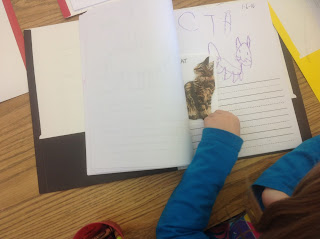One of the biggest areas of concern I hear from families is in regards to behavior. Parents so often come into the classroom and are shocked when they see their little one doing things in the classroom that don't always happen at home. Things like cleaning up after themselves, taking turns, following routines. Of course the school and home settings are vastly different and students tend to respond differently across both. There are a few strategies however that seem to carry over well across all settings to help promote positive behaviors. Below I have compiled some tips to help make that transition to being home all day long a little bit easier!
- Establish a sequential visual schedule. It doesn't need to be rigid, just a rough overview of your day so that littles can see what is coming up in their day and so they can take some initiative to be ready for transitions. Hanging up a series of pictures of the day's events in a place such as the kitchen is a great way to help little eyes to prepare for what is to come. Plus, it helps lessen the whole "I'M BORED!" chant that is so often heard all.day.long when you spend a day in the house with the kids. So really this one is just as much for your sanity as it is for theirs ;) Hang photos of the routine in a common area so that the schedule is easy to see and follow. For example, the first activity of the day can be a picture of breakfast, followed by clothing to signify getting dressed, then a picture of a park or shopping cart to represent an outing followed by a photo to signify lunchtime, a playdate, and so on. Even if you don't plan to leave the house at all, hang up a picture of the backyard to show outdoor play time, books to represent quite reading time, etc. Children need some sense of predictability and structure in order to avoid boredom and melt downs. Although it is important to give children much needed free time during the summer months, having some sort of predictability will help all to feel secure in what is to come each day. You can help them "read" the schedule at the start of each day and when they seem to be getting bored or having trouble finishing their food, remind them to check the schedule and encourage them to complete the task at hand so they can get to the next activity.
- Try to get out of the house a few times a week. You don't need to go broke to have a fun-filled summer with your babies! Park district activities, forest preserve hiking trails, library trips, even just a long walk or nature hunt through the neighborhood can be enough to help keep you all from going stir crazy and can provide great natural learning opportunities. Plus it provides simple ways to bond and soak up the time you are given with them.
- Reward positive behavior. This has to be one of my top favorites! If you do one thing on this list, let it be this one! I'm not sure if it is the Behavior Therapist in me or just my obsession with positive praise...but let those babies know when they are makin' you proud! If you catch them picking up a toy without being asked or sharing with their sibling, PRAISE them! You don't have to give them something tangible, just a simple compliment will do. Be specific and let them know you see them and appreciate all their good choices by saying something like "Thank you for putting your toy away! Mommy loves when you are so helpful." It is too easy to fall into the trap of over correcting, in school or home settings. Providing children with positive praise throughout the day encourages them to continue those behaviors that you actually want to see.
- Address negative behaviors as needed. When your child misbehaves, address it right then and there. Explain why their current behavior is not acceptable and help them to really learn it. They shouldn't be behaving just because you have asked them to or because you are standing there. Help them to understand why some behaviors are unacceptable so that it can be applied across all settings.











